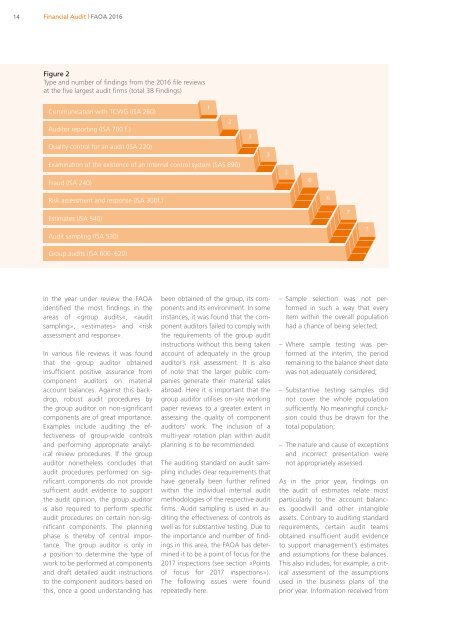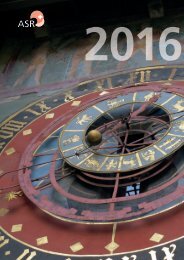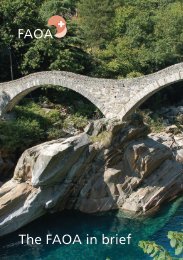Annual Report 2016
Annual Report 2016 - Federal Audit Oversight Authority FAOA
Annual Report 2016 - Federal Audit Oversight Authority FAOA
- No tags were found...
You also want an ePaper? Increase the reach of your titles
YUMPU automatically turns print PDFs into web optimized ePapers that Google loves.
14<br />
Financial Audit | FAOA <strong>2016</strong><br />
Figure 2<br />
Type and number of findings from the <strong>2016</strong> file reviews<br />
at the five largest audit firms (total 38 Findings)<br />
1<br />
Communication with TCWG (ISA 260)<br />
2<br />
Auditor reporting (ISA 700 f.)<br />
Quality control for an audit (ISA 220)<br />
Examination of the existence of an internal control system (SAS 890)<br />
Fraud (ISA 240)<br />
3<br />
3<br />
3<br />
6<br />
Risk assessment and response (ISA 300f.)<br />
6<br />
Estimates (ISA 540)<br />
Audit sampling (ISA 530)<br />
Group audits (ISA 600-620)<br />
7<br />
7<br />
In the year under review the FAOA<br />
identified the most findings in the<br />
areas of «group audits«, «audit<br />
sampling», «estimates» and «risk<br />
assessment and response».<br />
In various file reviews it was found<br />
that the group auditor obtained<br />
insufficient positive assurance from<br />
component auditors on material<br />
account balances. Against this backdrop,<br />
robust audit procedures by<br />
the group auditor on non-significant<br />
components are of great importance.<br />
Examples include auditing the effectiveness<br />
of group-wide controls<br />
and performing appropriate analytical<br />
review procedures. If the group<br />
auditor nonetheless concludes that<br />
audit procedures performed on significant<br />
components do not provide<br />
sufficient audit evidence to support<br />
the audit opinion, the group auditor<br />
is also required to perform specific<br />
audit procedures on certain non-significant<br />
components. The planning<br />
phase is thereby of central importance.<br />
The group auditor is only in<br />
a position to determine the type of<br />
work to be performed at components<br />
and draft detailed audit instructions<br />
to the component auditors based on<br />
this, once a good understanding has<br />
been obtained of the group, its components<br />
and its environment. In some<br />
instances, it was found that the component<br />
auditors failed to comply with<br />
the requirements of the group audit<br />
instructions without this being taken<br />
account of adequately in the group<br />
auditor’s risk assessment. It is also<br />
of note that the larger public companies<br />
generate their material sales<br />
abroad. Here it is important that the<br />
group auditor utilises on-site working<br />
paper reviews to a greater extent in<br />
assessing the quality of component<br />
auditors’ work. The inclusion of a<br />
multi-year rotation plan within audit<br />
planning is to be recommended.<br />
The auditing standard on audit sampling<br />
includes clear requirements that<br />
have generally been further refined<br />
within the individual internal audit<br />
methodologies of the respective audit<br />
firms. Audit sampling is used in auditing<br />
the effectiveness of controls as<br />
well as for substantive testing. Due to<br />
the importance and number of findings<br />
in this area, the FAOA has determined<br />
it to be a point of focus for the<br />
2017 inspections (see section «Points<br />
of focus for 2017 inspections»).<br />
The following issues were found<br />
repeatedly here.<br />
– Sample selection was not performed<br />
in such a way that every<br />
item within the overall population<br />
had a chance of being selected;<br />
– Where sample testing was performed<br />
at the interim, the period<br />
remaining to the balance sheet date<br />
was not adequately considered;<br />
– Substantive testing samples did<br />
not cover the whole population<br />
sufficiently. No meaningful conclusion<br />
could thus be drawn for the<br />
total population;<br />
– The nature and cause of exceptions<br />
and incorrect presentation were<br />
not appropriately assessed.<br />
As in the prior year, findings on<br />
the audit of estimates relate most<br />
particularly to the account balances<br />
goodwill and other intangible<br />
assets. Contrary to auditing standard<br />
requirements, certain audit teams<br />
obtained insufficient audit evidence<br />
to support management’s estimates<br />
and assumptions for these balances.<br />
This also includes, for example, a critical<br />
assessment of the assumptions<br />
used in the business plans of the<br />
prior year. Information received from
















